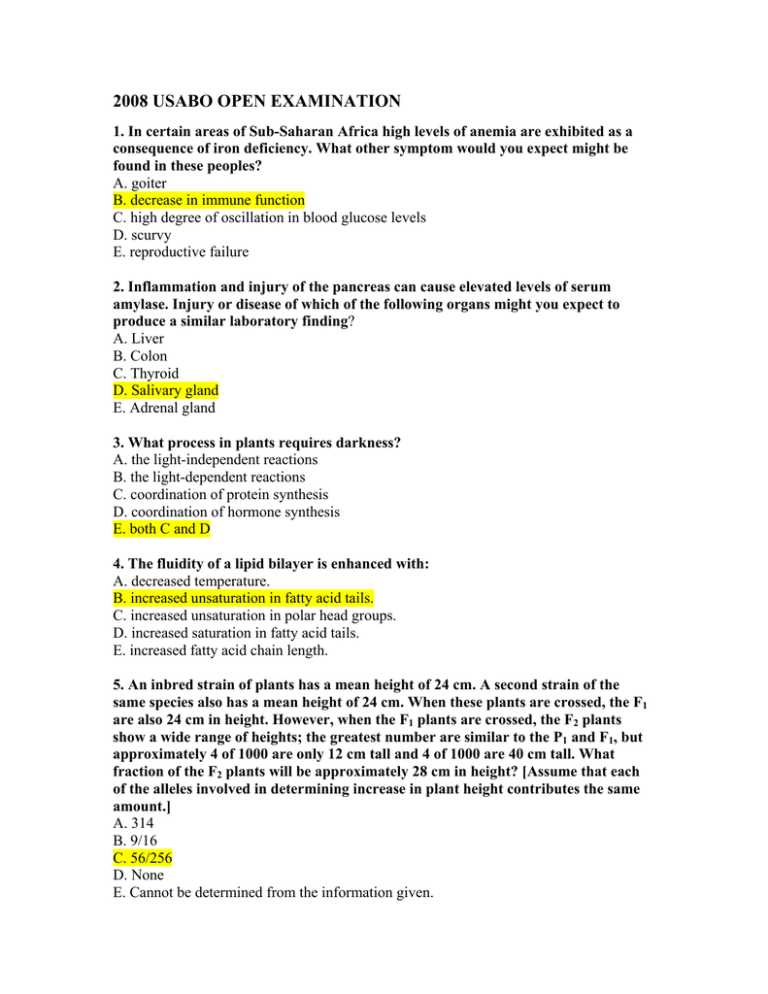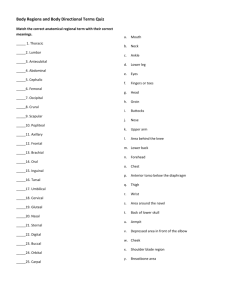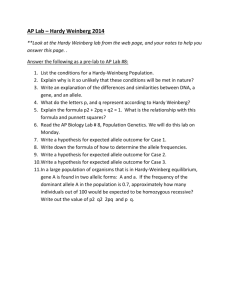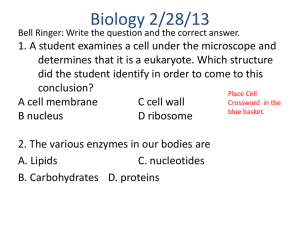2008 USABO OPEN EXAMINATION
advertisement

2008 USABO OPEN EXAMINATION 1. In certain areas of Sub-Saharan Africa high levels of anemia are exhibited as a consequence of iron deficiency. What other symptom would you expect might be found in these peoples? A. goiter B. decrease in immune function C. high degree of oscillation in blood glucose levels D. scurvy E. reproductive failure 2. Inflammation and injury of the pancreas can cause elevated levels of serum amylase. Injury or disease of which of the following organs might you expect to produce a similar laboratory finding? A. Liver B. Colon C. Thyroid D. Salivary gland E. Adrenal gland 3. What process in plants requires darkness? A. the light-independent reactions B. the light-dependent reactions C. coordination of protein synthesis D. coordination of hormone synthesis E. both C and D 4. The fluidity of a lipid bilayer is enhanced with: A. decreased temperature. B. increased unsaturation in fatty acid tails. C. increased unsaturation in polar head groups. D. increased saturation in fatty acid tails. E. increased fatty acid chain length. 5. An inbred strain of plants has a mean height of 24 cm. A second strain of the same species also has a mean height of 24 cm. When these plants are crossed, the F1 are also 24 cm in height. However, when the F1 plants are crossed, the F2 plants show a wide range of heights; the greatest number are similar to the P1 and F1, but approximately 4 of 1000 are only 12 cm tall and 4 of 1000 are 40 cm tall. What fraction of the F2 plants will be approximately 28 cm in height? [Assume that each of the alleles involved in determining increase in plant height contributes the same amount.] A. 314 B. 9/16 C. 56/256 D. None E. Cannot be determined from the information given. 6. The skin forming the flying surface in the wing of a bat and the feathers forming the flying surface in the wing of a bird: A. evolved from a similar structure in a common ancestor. B. are different because of adaptive radiation. C. do not develop from the same sources in the embryos of bat and bird, and are analogous. D. perform different functions in the bat and the bird. E. evolved in response to "felt need" in adult birds and bats. 7. Blood glucose level is regulated by two antagonistic hormones, glucagon and insulin. The following graph shows the fluctuations in an individual's blood glucose level over a five hour period. From the information provided above and your knowledge of physiology, which of the following statements are appropriate? I. Normal homeostatic mechanisms maintain a glucose concentration of approximately 1 mg/ml. II. Glucagon is released at points A and C. III. The individual eats a meal at point D. IV. Insulin is being released at points B and E. A. I only B. I and I1 only C. I and IV only D. I, 11, and 111 only E. 11, 111, and IV only 8. Your parents built a tree house for you when you were 8 years old and 4 feet tall. They placed the tree house on a branch of a tree that was 5 feet above the ground in a tree that was 20 feet tall. You are now 17 years old and 6 feet tall. The tree has grown to be 50 feet tall. How high above the ground is the branch on which the tree house is resting now? A. 4 feet B. 5 feet C. 17 feet D. 20 feet E. 35 feet 9. When they encounter a predator, small fish form schools that look like balls, thereby: A. avoiding the predator. B. attracting less attention. C. looking like another predator. D. escaping more rapidly. E. confusing the predator; it is difficult to pick on a single fish. 10. The inspiratory phase of mammal respiration is characterized by: A. expansion of the rib cage and contraction of the diaphragm. B. expansion of the rib cage and relaxation of the diaphragm. C. collapse of the rib cage and contraction of the diaphragm. D. collapse of the rib cage and relaxation of the diaphragm. E. contraction and relaxation of the diaphragm. 11. To be functional, a linear chromosome most often contains at least: A. two telomeres, two centromeres, and a large number of origins of replication. B. two centromeres and an origin of replication. C. one centromere and an origin of replication. D. two telomeres and an origin of replication. E. two telomeres, one centromere, and a large number of origins of replication. 12. In one form of Muscular Dystrophy, a sex-linked allele is the cause of the disorder. In this recessive form of the disorder the victims are almost invariably boys, who usually die before puberty. Why is this disorder almost never encountered in girls? A. Sex-linked allele cannot be inherited from mother to daughter. B. Nondisjunction does not occur in females, but does so in males. C. Sex-linked traits are never seen in girls. D. Males with the allele tend not to live long enough to reproduce. E. The Y chromosome is the site of the allele. 13. The following graph shows the affinity of hemoglobin for oxygen at three different pH levels. What effect would vigorous exercise have on hemoglobin in the muscles compared to normal physiological conditions? A. Hemoglobin will have the same affinity for oxygen. B. Hemoglobin will have a higher affinity for oxygen. C. Hemoglobin will have a higher affinity for oxygen only at very low or very high oxygen concentrations. D. Hemoglobin will have a lower affinity for oxygen. E. Hemoglobin will have a lower affinity for oxygen only at very low or very high oxygen concentrations. 14. Which of the following subdivisions of the autonomic nervous system would be most important to a zebra when it is fleeing from a lion? A. The enteric nervous system B. The parasympathetic nervous system C. Both the parasympathetic and enteric nervous systems D. The sympathetic nervous system E. The somatic nervous system 15. Which of the following statements is NOT true about the Ti plasmid? A. It is used in the agricultural industry to introduce foreign genes into plant cells. B. It is a tunlor inducing plasmid. C. It may trigger the production of antibodies in plant cells. D. It is naturally found in the Agrobacterium tumefaciens bacterium. E. Pieces of it may be incorporated into the host cell genome. 16. Which of the following graphs signifies the total cross-sectional area of blood vessels in humans as the blood flows from the aorta -> arteries -> arterioles > capillaries -> venules -> veins -> venae cavae? Answer: A 17. What effect do the processes meiosis and fertilization have on allele frequencies in a population? A. They reduce the frequency of deleterious alleles. B. They increase the frequency of advantageous alleles. C. They tend to selectively combine favorable alleles into the same zygote without changing overall allele frequencies. D. They tend to increase the frequency of new alleles and decrease the frequency of old ones. E. They have no direct effect on allele frequencies. 18. You find a chunk of petrified fossil wood and take it to a paleobotanist who identifies it as palm (monocot) wood. What is the basis of this identification? A. Only ground tissue and scattered vascular bundles occur in the specimen. B. There are numerous tiny growth rings. C. There is lots of heartwood and very little sapwood. D. There are almost equal amounts of spring wood and summer wood in each year's growth. E. The vascular cambium only appears active within vascular bundles. 19. Consider the activity of pepsin in the process of digestion. Below is the structural formula of a segment of a polypeptide. Which bond in the polypeptide (1 - 5) does pepsin hydrolyze? A. 1 B. 2 C. 3 D. 4 E. 5 20. The best index fossils that a paleontologist could use to assign relative ages to different strata of sedimentary rock would be those of: A. dinosaurs. B. shelled aquatic/marine organisms. C. bacteria. D. flightless birds. E. tunicates. 21. The endosperm of a plant with "monosporic" development has 72 chromosomes. How many chromosomes does the egg cell have? A. 24 B. 28 C. 72 D. 98 E. 120 22. In plant cells grown in the presence of a metabolic poison that specifically inhibits mitochondria1 FlATP synthase, one would expect: A. the pH difference across the cristae to be greater than normal. B. the pH difference across the cristae to be less than normal. C. the electron transport chain to become inoperative. D. oxygen consumption to cease. E. water to move out of the mitochondria by osmosis. 23. Net primary productivity, in most ecosystems, is important because it represents the: A. stored chemical energy that would be available to heterotrophs. B. total solar energy converted to chemical energy by producers. C. energy used in respiration by heterotrophs. D. energy available to producers. E. biomass of all producers. 24. The presence of a vertebral column is _____ with respect to all vertebrates [first term], but _____ with respect to all chordates [second term]. A. analogous; homologous B. analogous; derived C. derived; primitive D. homologous; analogous E. primitive; derived 25. Which two brain centers control mammalian respiration? A. Medulla oblongata and substantia nigra R. Substantia nigra and red nucleus C. Red nucleus and pons D. Medulla oblongata and red nucleus E. Medulla oblongata and pons 26. The universal distribution of antibiotics to poultry at commercial farms may have an adverse evolutionary effect because: A. Chickens prone to bacterial diseases may survive. B. Antibiotics kill young chick cells during development. C. It may allow antibiotic resistant E. coli strains to have selective advantage. D. Human retroviruses evolve more rapidly when exposed to antibiotics. E. Antibiotics increase in toxicity when passed through avian systems. 27. A farmer has three bulls. One day one of his prize cows entered her estrous cycle and somehow managed to get into the pasture with the bulls. As expected, the result of that adventure was a calf. However the farmer did not know which of the three bulls was the calf’s father. The farmer's extension agent told him that he might be able to find out by having the lab make a DNA "fingerprint" of the cow, the calf, and each of the three bulls at two or more loci. Below is the result of this genetic analysis at two loci. From the above information, which of the bulls could be the father? A. Bull 1 B. Bull 2 C. Bull 3 D. Bull 1 or 2 E. Any one of the 3 could be the father. 28. K+ secretion into the nephron tubule takes place at the: A. proximal tubule. B. descending loop of Henle. C. ascending loop of Henle. D. distal tubule. E. collecting duct. 29. You introduce the DNA sequence for the human αl-antitrypsin protein into a sheep. The sheep cells, however, do not produce any of your desired protein. What could you try to do to fix the problem? A. Ligate your human αl-antitrypsin coding sequence to the GFP coding sequence. B. Purify the αl-antitrypsin mRNA and express proteins in a cell-free system. C. Add an inducer of the T7 promoter, like IPTG. D. Cross two embryonic cells to make a diploid clone. E. Reintroduce the human αl-antitrypsin gene into your sheep using the human coding sequence under the control of a sheep promoter. 30. Scientists have determined that three classes of genes (named A, B, and C) control development of the four flower parts: Sepals, Petals, Stamen, and Carpels. Genes A and C mutually repress each other. Gene B is not regulated by either gene A or C. The expression pattern of these genes in wild-type flowers is shown below, where +++ indicates gene activity. A mutation in Gene C, which prevents its expression, will result in which of the following floral patterns? A. Sepals-Petals-Stamen-Carpels B. Sepals-Petals-Petals C. Sepals-Petals-Petals-Sepals D. Sepals-Petals-Petals-Carpels E. Sepals-Petals-Stamen 31. You are trying to isolate glyoxysomes and peroxisomes from a mixture of cellular organelles using differential centrifugation. After a few centrifugation steps, you think you may have a relatively pure suspension. How might you determine that your suspension does indeed include these organelles? A. Perform at1 assay for the enzyme succinate dehydrogenase. B. Perform an assay for the presence of nucleic acids. C. Perform an assay for the enzyme catalase. D. Examine microscopically for double membrane bound organelles. E. This cannot be determined experimentally. USE THE FOLLOWING INFORMATION TO ANSWER QUESTIONS 32-34. A large population of laboratory rats was allowed to breed randomly for a number of generations. In this population the A allele codes for agouti fur and a allele codes for black fur. At the beginning of the breeding cycles, 49% of the rats had black fur. At the end of the breeding cycles, this percentage was the same. The rest of the animals had agouti fur, with heterozygotes indistinguishable from homozygous dominants. 32. What is the most reasonable conclusion that you, the observer, should draw from the fact that the frequency of the recessive trait has not changed over time? A. The population is undergoing genetic drift. B. The genotype AA is lethal. C. The two phenotypes are about equally adaptive under these laboratory conditions. D. There has been a high rate of mutation from the A allele to the a allele. E. There has been sexual selection resulting in a greater overall frequency of the recessive allele in this population. 33. The estimated frequency of the a allele in these rats is: A. 0.07 B. 0.3 C. 0.42 D. 0.49 E. 0.7 34. What proportion of this population is probably heterozygous for the fur color alleles? A. 0.42% B. 0.07% C. 0.3% D. 0.49% E. 0.7% 35. Placing a ripe apple in a bag of green bananas will cause them to ripen quickly. This is because the apple: A. absorbs cytolcinin. B. forms digestive enzymes. C. makes auxin. D. produces ethylene gas. E. absorbs heat better than bananas. 36. To control overpopulation by rabbits, investigators introduced a myxoma virus into the population. The following graph indicates density of the population in no./km2, and annual rainfall in the region over a 14 year period. What is the likely explanation for the change in rabbit density over this period? A. A fox population increased as a consequence of years of high rainfall, thus more rabbits were killed. As the rabbit population decreased, foxes began to starve, decreasing the fox population and the rabbit population increased again. B. The myxoma virus killed most of the rabbits but a few acquired resistance to the virus and passed this trait on to their offspring, thus resulting in an increased rabbit population. C. The myxoma virus initially killed most of the rabbits but over the years lost its potency due to the accumulation of deleterious mutations. D. Drought killed most of the rabbits between 1960 and 1964 after which environmental conditions improved. E. The myxoma virus killed most of the rabbits but a small number had natural resistance to the virus and passed this trait on to their offspring. 37. An increase in plasma parathyroid hormone levels would lead to which of the following? A. An increase in the number of active osteoblasts B. An increase in uptake of calcium ions by the bone C. A decrease in Vitamin D synthesis D. An increase in renal reabsorption of calcium ions E. A decreased absorption of calcium in the intestine 38. Nucleotide excision repair of pyrimidine dimers uses which of the following enzyme(s)? A. photolyases B. nucleases, DNA polymerases and DNA ligases C. exonucleases and DNA ligases D. restriction endonucleases and DNA polymerases E. restriction endonucleases and DNA ligases 39. A farmer was interested to test the effect of various fertilizers on wheat production. He subdivided a four acre plot of land into four plots of one acre each. He added no fertilizer to Plot #1, he added only nitrogen to Plot #2, he added only phosphorus to Plot #3, and both nitrogen and phosphorus to plot #4. Each month he estimated the biomass of each plot. A plot of these data is shown below. Which of the following statements is supported by these data? A. Phosphorus was the first limiting nutrient followed by nitrogen. B. Nitrogen was the first limiting nutrient followed by phosphorus. C. Phosphorus was limiting but nitrogen was not limiting. D. Nitrogen was limiting but phosphorus was not limiting. E. Neither nitrogen nor phosphorus was limiting. 40. A decrease in cortisol secretion would lead to a(an): A. decrease in epinephrine synthesis. B. decrease in ACTH synthesis. C. increase in blood glucose concentration. D. increase in blood pressure. E. increase in the body mass index. 41. Which of the following is not shared between the Magnoliophyta and the Pinophyta? A. Siphonogamy B. Ovule C. Endosperm D. Tracheids E. Megaphylls 42. Plants that experience cold winters often change the composition of their membranes and/or cytoplasm in order to survive cold conditions. Which of the following molecules are often actively increased in concentration? I. Cholesterol II. Sugars III. Ionic Salts IV. Unsaturated fatty acids. A. IV B. II, IV C. II, III D. II, III, IV E. I, II, III, IV 43. John, 45-years-old, ran his first marathon in Denver, Colorado, with a time of 3 hours and 43 minutes. Running hard at Mile-23: A. John's abdominal muscles increased his intra-abdominal pressure, which is forcing his abdominal viscera upward against his diaphragm. His intrapulmonary pressure at Mile-23 may have decreased by as much as 80 mmHG since the beginning of the marathon. B. John's abdominal muscles decreased his intra-abdominal pressure, which are forcing his abdominal viscera upward against his diaphragm. His intrapulmonary pressure at Mile-23 may have increased by 80 mmHG since the beginning of the marathon. C. John's abdominal muscles increased his intra-abdominal pressure, which are forcing his abdominal viscera upward against his diaphragm. His intrapulmonary pressure may have increased by 80 mmHG since the beginning of the marathon. D. John's abdominal muscles decreased his intra-abdominal pressure, which are forcing his abdominal viscera upward against his diaphragm. His intrapulmonary pressure may have decreased by 80 mmHG since the beginning of the marathon. E. John's abdominal muscles decreased his intra-abdominal pressure, which are forcing his abdominal viscera upward against his diaphragm. His intrapulmonary pressure stayed the same since the beginning of the marathon. 44. While walking to school one day, you notice a group of purple ants who all walk sideways. Excited by your discovery, you decide to classify your ants. Which of the following characteristics would classify the purple ants as a new subspecies or strain of ants and NOT a new species? A. The purple ants have a similar DNA polymerase as the tropical fire ant Solenopsis geminate. B. The purple ants may produce fertile offspring when crossed with Solenopsis geminate. C. The purple ants have ribosomal subunits of the same size as Solenopsis geminate. D. The purple ants are found to inhabit similar areas as Solenopsis geminate. E. Both b and d are necessary characteristics. 45. Color-blindness is a recessive, X-linked trait. A couple, who are both blood type A and who both have normal vision, have a son who is blood type O and colorblind. What is the probability that their next child will be a daughter who is blood type O and has normal vision? A. 112 B. 114 C. 118 D. 1/16 E. Zero - Not possible 46. Which statement is NOT TRUE about the effects of various conditions on the activity of an enzyme? A. Higher temperatures generally increase the activity of an enzyme, up to a point. B. Above a certain range of temperatures, an enzyme will be denatured. C. Change in pH can cause an enzyme to be inactivated or denatured. D. An enzyme's activity is generally reduced by an increase in enzyme concentration, due to competition for the active site. E. In the presence of an inhibitor, enzyme activity will be decreased. 47. The fact that transfer cells have many mitochondria supports the statement that transfer cells likely move certain substances by means of: A. tension pressure. B. facilitated diffusion. C. simple diffusion. D. active transport. E. translocation. 48. The coefficient of relatedness between an uncle and his nephew is: A. 0.125. B. 0.25. C. 0.5. D. 1.0. E. Cannot be determined. Questions 49 and 50 refer to the diagram below regarding a mountainous region. The diagram shows the average winter temperature (left-hand y-axis) at different altitudes (x-axis) and the abundance of three tree species (right-hand y-axis) at different altitudes (x-axis). 49. Which tree species is fare found in areas where the average winter temperature is below 0°C? A. Species 1 only B. Species 2 only C. Species 3 only D. Species I and 2 only E. Species 2 and 3 only 50. Which species is/are found below an altitude of 500m? A. Species 1 only B. Species 2 only C. Species 3 only D. Species 1 and 2 E. Species 2 and 3




